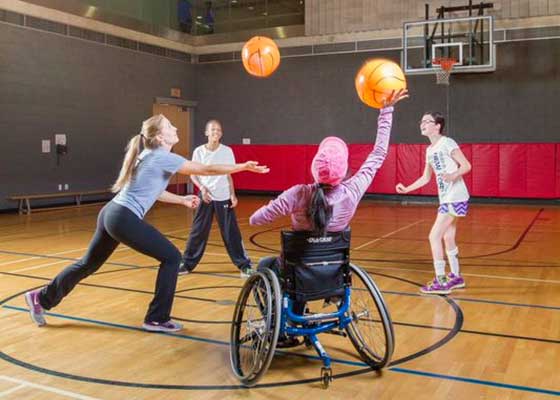
Beyond Parapan: promoting inclusiveness in sport at the community level
Published: August 12, 2015
The Parapan Am Games are in full swing, showcasing what elite athletes can accomplish and how they can perform on the world's stage.
What the University of Toronto's David Onley has called the “raw athleticism” of the world-class athletes is drawing spectators to a wide range of sports. And, thanks to two U of T researchers, excitement and inclusiveness in sport is also growing at the community level.
Assistant Professor Kelly Arbour-Nicitopoulos and Associate Professor Virginia Wright have developed a pilot program called Igniting Fitness Possibilities that brings together children and youth of all levels of abilities to gain skills and confidence in sport and fitness. It was created as a collaboration between Holland Bloorview Kids Rehabilitation Hospital and the Faculty of Kinesiology & Physical Education with funding from The National Bank, Milos Raonic and the U of T Connaught New Researcher Award.
U of T News spoke to Arbour-Nicitopoulos about the program and what it means to build a life-long enjoyment of fitness in both non-athletes and future athletes alike.
How does Igniting Fitness Possibilities work?
The program brings children and youth in grades 4 to 12 with and without disabilities together, first and foremost for the social aspect. The kids involved build new friendships and are getting motivated to be more active.
There are two phases to the program. The first is the Quick Start phase. The sole focus of this phase is to help build sports and fitness skills, and participating in sports, but also other existing programs in the community.
The kids get to take part in fitness activities, sports development and collaborative games. The games could be wheelchair basketball, for example, where the students learn how to use a wheelchair and how to manoeuvre it. The fitness portion consists of aerobic and muscular endurance activities performed as a group as well as in partners, such as circuits and yoga.
In the second phase, “Give it a Try”, the kids start in an existing program offered within their community. A lot of kids lack the skills or confidence initially, which they get in the “Quick Start” phase. In this phase the kids join such programs as wheelchair basketball, swimming, gymnastics, fencing, judo – basically any sport or fitness program that is of interest to them. We have a coach who supports them throughout both phases. This coach works with every six kids, trying to pique their interest to see what they might want to give a try.
The program is in its early stages, but so far we piloted IFP at Variety Village (Fall 2014 – grades 4-6) and at the Abilities Centre (Winter 2015 – grades 6-8) in Whitby. We will be piloting another two programs at U of T (with youth in grades 9-12) and again at the Abilities Centre (with youth in grades 6-8) this Fall.
How important is it to get kids involved early?
By the end of Quick Start the kids surprise themselves by how much they enjoy sports. They see that sports do not have to be regimented and that there are different ways of playing sports. My hope is that when we follow up with those kids later on they would have a different view about the variety of sports that they can play and enjoy.
We’re trying to do a better job than we were doing years ago. Many of the kids who are disabled would not have had the opportunity to participate in different sports within their neighbourhoods. The level of awareness for sports for people with different abilities has exploded in a big way.
Bringing the Parapan Am Games here is making people aware of the different sports in which para-athletes participate.
How does that benefit the city?
I think that having the Games here in Toronto is raising more awareness about how we use the term ‘disability’. What do we mean by that? What does it mean to have a disability? When you look at the Para Pan athletes I don’t think anyone can say that they have a disability. It gets people thinking more about the term ‘ability’ as well as accessible spaces.
When I went to Nathan Phillips Square (for Panamania), I was amazed how every space was accessible. The city and the government have contributed quite a large amount of funding to make spaces more accessible for the games, and as a result Torontonians now have more accessible spaces to be active in their community.
At the U of T reception of the Parapan Am Games, Joanne Berdan spoke of the term paratough, which was recently coined by the Canadian Paralympic Committee. That’s so true. The disability part is slowly going away, and people are recognizing the tremendous talent of these individuals. I’m hoping that the IFP program will provide one of many similar opportunities for kids in the future.



